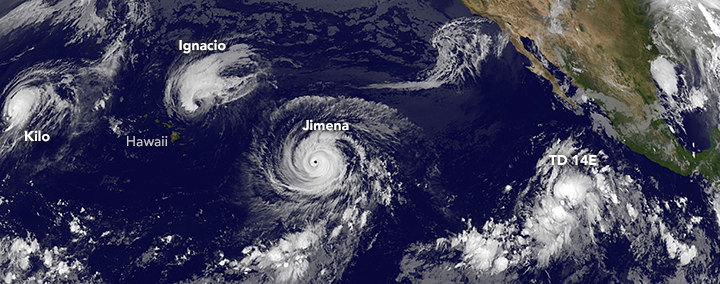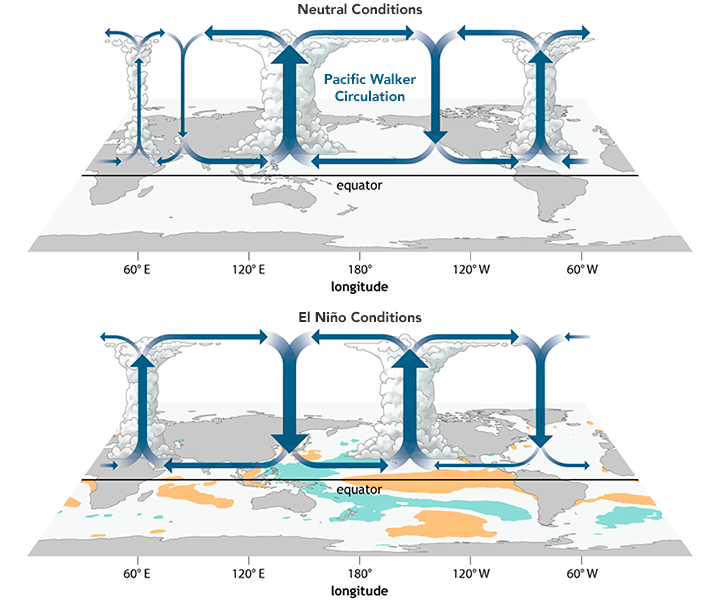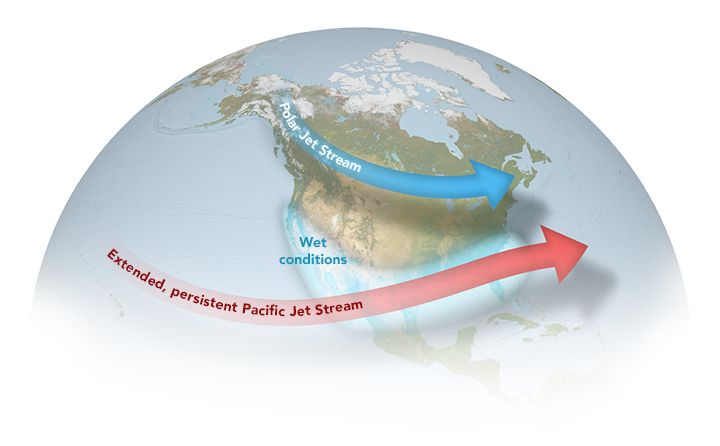Global Rainfall Trends: Understanding the Impact of El Niño and La Niña
The Earth's climate is a complex system that is influenced by a variety of factors, including ocean temperatures, atmospheric pressure, and global weather patterns. One of the most significant climate phenomena that can impact global rainfall patterns is the El Niño-Southern Oscillation (ENSO).

Figure 1: The GOES-West satellite observed four tropical cyclones roiling the Pacific on September 1, 2015, during an El Niño event. (Image courtesy of the NASA/NOAA GOES Project.)
ENSO is a natural climate phenomenon that involves fluctuations in ocean temperatures and atmospheric pressure in the Pacific Ocean. During an El Niño event, warmer than normal water accumulates in the central and eastern Pacific Ocean, leading to increased rainfall in some regions, while other regions experience drought conditions. Conversely, during a La Niña event, cooler than normal water accumulates in the central and eastern Pacific, leading to decreased rainfall in some regions, while other regions experience increased rainfall.
ENSO can have a significant impact on global rainfall patterns, as it can influence the direction and intensity of storms and the distribution of precipitation. During an El Niño event, for example, the increased rainfall in the central and eastern Pacific can lead to drought conditions in regions such as Indonesia and northern Australia. Conversely, during a La Niña event, the decreased rainfall in the central and eastern Pacific can lead to increased rainfall in regions such as northern South America.

Figure 2: Atmospheric circulation over the equator—the Walker circulation—changes substantially with the arrival of El Niño. (Illustration by NOAA/Climate.gov)
Because of the vastness of the Pacific basin—covering one-third of the planet—these wind and humidity changes get transmitted around the world, disrupting circulation patterns such as jet streams (strong upper-level winds). We know these large-scale shifts in Pacific winds and waters initiate El Niño. What we don't know is what triggers the shift. This remains a scientific mystery (NASA Earth Observatory).

Figure 3: El Niño usually alters the Pacific jet stream, stretching it eastward, making it more persistent, and bringing wetter conditions to the western U.S. and Mexico. (NASA Earth Observatory illustration by Joshua Stevens.)
However, it's important to note that ENSO is not the only factor that determines global rainfall patterns. Other factors such as local topography, land-use changes, and human activities can also impact local and regional rainfall patterns. While ENSO can have a significant impact on global rainfall patterns, the frequency, intensity, and duration of ENSO events can vary from year to year, making it difficult to predict the exact impact that ENSO will have on global rainfall patterns in the future. In order to better understand the impact of ENSO on global rainfall patterns, researchers and meteorologists use a variety of tools and techniques, including computer models and satellite data, to analyze and predict the effects of ENSO.
The El Niño-Southern Oscillation (ENSO) is a natural climate phenomenon that can have a significant impact on global rainfall patterns. By understanding the effects of ENSO, and by using a variety of tools and techniques to analyze and predict its impact, we can gain a better understanding of the Earth's climate and the factors that influence it.
Major Satellite Data Sources:
Link: https://neo.gsfc.nasa.gov/view.php?datasetId=GPM_3IMERGM
This website provides the rainfall maps that show total monthly rainfall in millimeters from NASA’s Integrated Multi-satellite Retrievals for GPM (IMERG) dataset and also provide Tropical Rainfall Measuring Mission (TRMM) satellite dataset. Anyone can download the global rainfall dataset from 1998 to present time with different data formats (like JPG, GEOTIFF and NetCDF).
This website was produced with the support of the United States Agency for International Development (USAID) under the terms of USAID's Research for Decision Makers (RDM) Activity cooperative agreement no. AID-388-A-17-00006
Views expressed herein do not necessarily reflect the views of the U.S. Government or USAID. icddr,b is also grateful to the Governments of Bangladesh, Canada, Sweden and the UK for providing unrestricted/institutional support
68, Shaheed Tajuddin Ahmed Sarani Mohakhali, Dhaka 1212, Bangladesh
icddr,b is located at the Mohakhali area in Dhaka, just ask your driver for the "Cholera Hospital"
